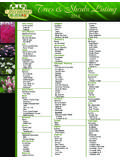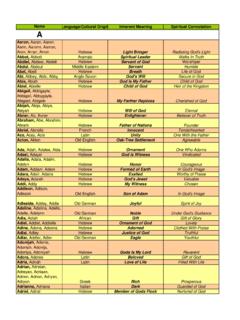Transcription of HOW TO MAKE A 14th CENTURY TRESTLE TABLE
1 HOW TO MAKE A14th CENTURYTRESTLE TABLEBy Baron Thorvald Olafson8/1/01 SKILLS AND TOOLS REQUIRED This project is designed for a craftsman with a moderate skill level. It should not be attempted by a begining woodworker, without the guidance or help of a experienced woodworker. Power tools needed: a tablesaw, a drill and a saber saw are needed for this project although a portable belt sander, and a detail sander make finish work easier and faster. Hand tools required: chisels and a mallet, sanding blocks, a scraper and a variety of different grit sand paper will be SHORT HISTORICAL BACKGROUND The use of TRESTLE tables goes back as far as Roman and classical Greek times.
2 Put verysimply: TRESTLE tables were the folding tables of their time. The top rested on some mannerof base and it all came apart to take up less space when not needed. The TRESTLE TABLE became very popular in the Middle Ages, when many early forts and castles were designed for defense, not for comfort. All the people who lived in the castle would gather in the common room, or great hall, and eat together. Afterwards the TABLE would be cleaned, dismantled and stored to one side. Then as the Lord, Lady and family of the castle would retire to their private rooms, everyone else would pull out straw pallets (if they were so lucky), or more likely just blankets, and sleep on the floor of the great hall.
3 During the day the hall was cleared to allow business as the Lord saw fit. As time progressed, the castles became more a symbol of power and prestige and less likely to have to act as defense. The population centers started to grow, and out of those, craftsmen flourished. The castles and manors started looking, and functioning, more like homes rather than the stark fortresses they were before. Because of this change, furniture, though still very useful, became part of the interior decorations that made it seem more "homey". The styling of everyday furniture became more ornate and involved as time went on.
4 The TABLE shown here is based on a TABLE built in England around the year 1520 (see Figure 1). The original TABLE is made from Elm, a light colored wood similar to Poplar. Almost any wood will work, although I chose Ash for my TABLE . It's strong, but lighter than oak and has (in my opinion) a more distinctive "figure" or grain. I strongly recommend that a hard wood be used for durability. Hardwood is definitely more expensive but you get an excellent, quality piece of furniture when you are done. I have deviated from the original design in a couple of ways. The tabletop of the original is 22 1/2" wide x 9'-0" long and 2" thick, and was most likely a single plank; my tabletop is 30" wide x 60" long and 1 1/2" thick.
5 I planned to use this TABLE for SCA events so I wanted it to be a manageable size. For the shapes of the legs I used a design that was more to my liking rather than those shown on the original. I have included a scaled pattern of the original, as well as my custom pattern. BUYING THE LUMBER I used 3/4" thick lumber to make the tabletop and 1 1/2" thick lumber for the legs and stretchers. Hardwood lumber comes in various widths, you will have to calculate how much wood to buy based on the widths available. It is best to purchase 10 to 20% more than you need to allow for mistakes or unforeseen problems.
6 Make sure your lumber is straight and flat. Most hardwood lumberyards will offer the wood in various ways: rough sawn, S2S, S3S, S4S. The"rough sawn" term should be obvious, the other terms though relate to how many sides have been finished. You want S3S or S4S. That way you ll have two finished sides and at least one edge to use as a guide while THE TABLETOP The original tabletop was made from one plank of wood. Because of weight and cost I chose to layer the 3/4" lumber and make it appear twice as thick. You will want to start by gluing together several pieces of wood to make a "plank" measuring 31" x 61", 3/4" thick.
7 This is 1" larger than our final size; the extra (1/2" per side) will be trimmed off later when the tabletop is squared up and finished. Since the lumber is in random widths, cut enough lengths until you have a width of 31". Don't worry about uniformity, a 1" wide board next to a 6" wide board will look fine. Look at the grain on the edge of the wood. The grain will show as growth rings. The inside of the radius is the side which grew closer to the heart of the tree, the outside of the radius is the bark side. Align the wood so that each piece of wood alternates in the direction the rings curve; (see Figure 2).
8 Mating the wood planks this way will keep your tabletop flatter and it will be less likely to get splits in the wood. You can use dowel pins or biscuits to help align the wood planks together, but just gluing the wood will still give you a good solid join. There are many types of wood glue available. Some set fast, some slow, it's mostly a matter of preference. I like to use Tightbond Wood Glue. Apply enough glue to fully coat each edge. Use a damp rag to clean up any excess glue,while it's wet, that sqeezes out when clamping the tabletop together. Set aside to allow the glue to set. Next is building up the edge.
9 Cut two 2" wide x 3/4" thick x 61" long strips of wood. Glue these to the underside of the tabletop "plank" to thicken the long edgesto 1 1/2" thick (see Figure 3).Cut filler blocks 2" long to thicken the short ends of the Tabletop, glue into place (see Figure 4). The grain has to go the same direction as the tabletop or it won't look right. When you're done you have a top that looks like a solid 1 1/2" thick top but is almost half the weight. It gives the TABLE that massive look that is so common in medieval furniture. Trim and square off the tabletop to 30" x 60". Then smooth thesurface of the tabletop using an electric belt sander, a plane or a sanding block.
10 Each has it own pluses and minuses. Be carefull with the belt sander, one slip can cause a pretty deep groove, which you ll have a very hard time removing. Next, add the locator blocking for the legs: cut two pieces of wood 1 1/2" thick 3" x 16"; drill two holes as indicated in Figure 5 shows where to glue the Locator Blocking. The Locator Blocking does three things. First, it locates and centers the TABLE top onto the legs and stretchers. Second, it helps stabilize the top and keeps it from warping. Third, during the final assembly, dowels are put through the holes into corresponding holes in the legs.





